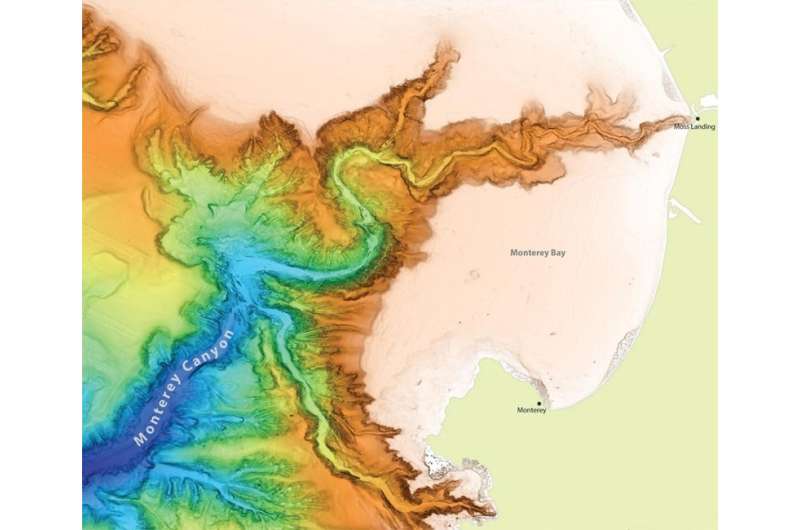Global analysis of submarine canyons may shed light on Martian landscapes

Submarine canyons are a final frontier on planet Earth. There are thousands of these breathtaking geological features hidden within the depths of the ocean—yet scientists have more high-resolution imagery of the surface of Mars than of Earth's ocean floor.
In an effort to shed light on these mysterious underwater features, Stanford researchers analyzed a collection of global images from an online repository of data from the ocean floor. They found that submarine canyons, which had been believed to form in ways similar to canyons on land, are instead fundamentally different from the land-based ravines that cut through vast stretches of our mountain ranges. The research was published online in Geology Sept. 25.
"People would say, 'Oh well, there is no real difference between the two systems because at the end of the day, a river flowing versus a sediment gravity flow flowing—they're just going to do the same thing,'" said lead author Stephen Dobbs, a Ph.D. candidate in geological sciences. "And it turns out that's not necessarily the case."
The researchers analyzed multi-beam sonar data, which is collected by ships or small underwater vehicles just above the sea floor that send a sonar wave that is used to make maps of the seafloor. They acquired data for the study from the Global Multi-Resolution Topography synthesis, an open-source online repository. Dobbs said it was surprising to discover differences in the underwater and above-ground canyons, since on a map, formations 9,000 feet underwater can't be distinguished from canyons that are 9,000 feet above ground.
"When you look from a purely qualitative sense—when you're just looking at a map—they look shockingly similar," said Dobbs. "We needed to use a quantitative method to actually test if these are different systems."
The scientists found distinctions in the shapes and profiles of submarine canyons. On land, significant changes in canyon shape are often triggered by large flood events or landslides. Under water, researches hypothesize processes that form submarine canyons are periodic landslides from extreme steepness, seismic activity or large winter storms that funnel a lot of sediment from the shallow continental shelf.
"This is all frontier—we don't actually know the answers to these things," Dobbs said. "Now we have all these measurements and we can more aptly look at what causes these formations."
From classroom to peer review
The student-led research grew out of a graduate seminar exploring submarine canyons held in spring of 2018. The colloquium brought together graduate students from two different laboratories—those of geological sciences professors Don Lowe and Stephan Graham. The research was guided by co-authors George Hilley, a professor of geological sciences, and adjunct professor of geological sciences Tim McHargue, who are both part of Stanford Earth's sedimentary research group along with Lowe and Graham.
Hilley said most people don't realize that sediment-laden water can erode the seafloor, never mind the fact that these flows have carved features deeper than the Grand Canyon right off the coast of Monterey. Because a lot of high-resolution imagery has been collected in recent years, the faculty members knew it should be possible to analyze a large sampling of the underwater features.
"We used the seminar as a vehicle for answering whether or not the forms produced by these density flows share essential characteristics with those produced by rivers," Hilley said. "By asking these questions using real data, everyone learned how to formulate hypotheses and falsify them using sophisticated data analysis."
While the project was a deviation from the graduate students' main research projects, Dobbs said he was pleased with how much the group accomplished in one year of pursuing this new topic.
Application to Mars?
Dobbs said he is excited about the prospect of using these methods to understand not only geology on Earth but also on other planets. For example, it could help researchers understand Martian landscapes, which are pocked with features that may share similarities with Earth's canyons. The research is also relevant to ocean-dependent industries, including communications companies—whose data cables can be severed by events in submarine canyons—as well as offshore energy and oil and gas operations.
"These things have huge impacts on Earth systems and they are fundamentally not understood," Dobbs said. "We're just now able to actually measure them in a rigorous geomorphic sense and from that, we're able to make inferences about both how they form and how they influence our systems and our cycles."
Dobbs plans to continue working with this data set in order to learn more about submarine canyon formation and behavior.
"The exciting thing for me is that—while I love fieldwork—we can literally discover new things using very simple tools that are available to the public and open access," he said.
More information: Stephen C. Dobbs et al, Are submarine and subaerial drainages morphologically distinct?, Geology (2019). DOI: 10.1130/G46329.1
Journal information: Geology
Provided by Stanford University




















